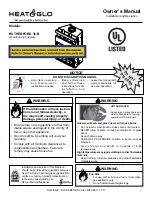
23
2.5 Maintaining The Fire
Your Osburn stove will work best if a thick bed of hot embers is maintained in the bottom of the firebox,
and a minimum of two large pieces of seasoned fuel are added. Combustion efficiency is largely related to
establishing a hot ember bed, and hot firebox temperatures. The quicker the stove and fuel get up to
operating temperature, the better. A small intense fire is preferred to a large smouldering fire, both to
improve combustion efficiency and to reduce the amount of creosote emitted. The best performance will
be obtained by adding relatively small amounts of fuel to a well established ember bed, and then operating
with the air inlet control open long enough to achieve a hot fire. Cordwood should be placed with air in
between individual pieces. Use a poker to make an air channel in the embers below the wood, this will
allow air to flow under the wood for a more efficient burn.
Extended burn times can be accomplished by first operating the stove on a full load with the air inlet
controls wide open. Once the fire is well established, and the moisture has been driven out of the wood,
reduce the air control to a low setting. The unit should then burn cleanly without smoldering. If the fire
smolders without flame, re-establish a hotter fire before moving the air control to the low setting. A yellow
flame burning in the top of the firebox is a good indication of a clean efficiently burning fire.
Refuelling technique is important for good performance. The best efficiency and performance from your
stove can be achieved by adding partial loads of fuel and allowing them to get up to operating temperature
before adding additional fuel. Adding a large amount of fuel at one time will increase the time required to
get the fuel up to its ignition temperature, and an extended time to reach optimal performance. When
refueling, open the air control or hold the door partially open 1” (25 mm) or less long enough (less than 5
minutes) so that the fire has well established flames. When refuelling, care is required to ensure that fuel
or embers do not fall out of the door opening. The unit will burn at about 2.0 to 2.5 lb/hr (.9 to 1.1kg/hr) at
its minimum setting; approximately 20 to 25 lbs (9 to 11.3kg) of wood are required for an extended burn.
In order to achieve an optimum efficiency from your unit, we suggest that you operate it with the air
control completely closed. Make sure that you have a good fire going and an adequate ember bed before
you completely close the air control. Use a chimney thermometer if necessary. Closing the air control too
soon will lower combustion efficiency and may cause the fire to die out. The addition of a blower (if not
already included) is highly recommended to maximize your unit’s efficiency.










































